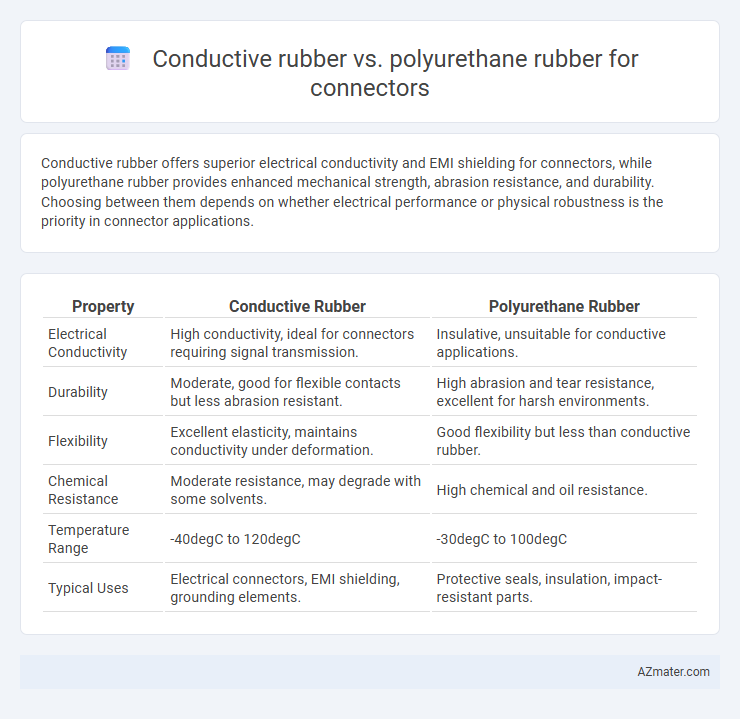Conductive rubber offers superior electrical conductivity and EMI shielding for connectors, while polyurethane rubber provides enhanced mechanical strength, abrasion resistance, and durability. Choosing between them depends on whether electrical performance or physical robustness is the priority in connector applications.
Table of Comparison
| Property | Conductive Rubber | Polyurethane Rubber |
|---|---|---|
| Electrical Conductivity | High conductivity, ideal for connectors requiring signal transmission. | Insulative, unsuitable for conductive applications. |
| Durability | Moderate, good for flexible contacts but less abrasion resistant. | High abrasion and tear resistance, excellent for harsh environments. |
| Flexibility | Excellent elasticity, maintains conductivity under deformation. | Good flexibility but less than conductive rubber. |
| Chemical Resistance | Moderate resistance, may degrade with some solvents. | High chemical and oil resistance. |
| Temperature Range | -40degC to 120degC | -30degC to 100degC |
| Typical Uses | Electrical connectors, EMI shielding, grounding elements. | Protective seals, insulation, impact-resistant parts. |
Introduction to Conductive and Polyurethane Rubber for Connectors
Conductive rubber utilized in connectors offers excellent electrical conductivity and EMI shielding, making it ideal for high-performance electronic applications requiring reliable signal transmission. Polyurethane rubber provides superior mechanical strength, flexibility, and resistance to abrasion and chemicals, ensuring durable connector seals in harsh environments. Selecting between conductive and polyurethane rubber depends on balancing electrical performance needs with environmental protection and mechanical durability.
Material Composition: Conductive Rubber vs Polyurethane Rubber
Conductive rubber for connectors primarily consists of silicone or natural rubber infused with conductive fillers like carbon black, silver, or nickel, enabling excellent electrical conductivity and flexibility. Polyurethane rubber, composed of urethane polymers, offers superior mechanical strength, abrasion resistance, and chemical stability but lacks inherent electrical conductivity. The material composition differences directly impact performance, with conductive rubber suited for electrical transmission in connectors, while polyurethane rubber excels in durability and insulation.
Electrical Conductivity Comparison
Conductive rubber exhibits significantly higher electrical conductivity due to the incorporation of conductive fillers like carbon black or silver particles, enabling efficient signal transmission in connectors. Polyurethane rubber, typically an insulating material, lacks inherent conductivity and requires surface treatments or additives to achieve minimal electrical performance. For applications demanding reliable electrical connections, conductive rubber provides superior conductivity and consistent performance compared to standard polyurethane rubber.
Mechanical Properties and Durability
Conductive rubber offers excellent electrical conductivity with moderate mechanical strength and flexibility, making it ideal for connectors requiring reliable signal transmission under dynamic conditions. Polyurethane rubber provides superior mechanical properties, including high tensile strength, abrasion resistance, and durability, ensuring long-lasting performance in harsh environments. The choice between conductive rubber and polyurethane rubber depends on balancing electrical requirements with mechanical robustness and environmental endurance in connector applications.
Flexibility and Elastic Recovery
Conductive rubber offers superior flexibility and excellent elastic recovery, allowing connectors to maintain consistent conductivity under repeated mechanical stress and deformation. Polyurethane rubber provides higher tensile strength and abrasion resistance but exhibits lower flexibility and slower elastic recovery, potentially compromising connector performance in dynamic applications. Selecting conductive rubber ensures optimal electrical contact reliability through enhanced material resilience and shape retention.
Chemical and Environmental Resistance
Conductive rubber offers excellent chemical resistance, particularly against oils, fuels, and solvents, making it suitable for connectors exposed to harsh industrial environments. Polyurethane rubber demonstrates superior resistance to abrasion, ozone, and weathering, providing long-term durability in outdoor or chemically aggressive conditions. Both materials excel in environmental resistance, but polyurethane's enhanced UV and ozone stability often makes it the preferred choice for connectors subjected to prolonged environmental exposure.
Common Applications in Connector Technology
Conductive rubber is widely used in connectors for electromagnetic interference (EMI) shielding and grounding due to its excellent electrical conductivity and compressibility, making it ideal for electronic devices, telecommunications, and automotive connectors. Polyurethane rubber offers superior mechanical strength, abrasion resistance, and environmental durability, which suits it for high-performance connectors in industrial machinery, aerospace, and harsh outdoor environments. Choosing between conductive rubber and polyurethane rubber depends on application requirements such as conductivity, mechanical stress, and exposure to environmental factors in connector technology.
Cost Effectiveness and Manufacturing Considerations
Conductive rubber offers excellent electrical conductivity and flexibility, making it ideal for connectors requiring reliable signal transmission, but typically incurs higher raw material costs compared to polyurethane rubber. Polyurethane rubber provides superior mechanical strength, abrasion resistance, and cost-effectiveness for large-scale manufacturing, though its lower conductivity often necessitates additional conductive fillers or coatings for electrical applications. Manufacturing considerations highlight that conductive rubber requires precise formulation and processing to maintain conductivity, whereas polyurethane rubber benefits from easier molding and faster production cycles, reducing overall manufacturing expenses.
Performance in High-Frequency and EMI Shielding
Conductive rubber offers superior EMI shielding effectiveness due to its embedded conductive fillers, making it ideal for high-frequency applications where signal integrity is crucial. Polyurethane rubber, while providing excellent mechanical durability and flexibility, generally exhibits lower conductivity and shielding performance, which can limit its effectiveness in mitigating electromagnetic interference at elevated frequencies. Selecting conductive rubber ensures optimized performance for connectors requiring reliable high-frequency signal transmission and robust EMI protection.
Choosing the Right Rubber Material for Connector Needs
Conductive rubber offers excellent electrical conductivity and EMI shielding, making it ideal for connectors requiring reliable signal transmission and grounding. Polyurethane rubber provides superior mechanical strength, abrasion resistance, and chemical durability, suitable for connectors exposed to harsh environmental conditions. Selecting the right rubber material depends on balancing electrical performance with environmental resilience based on application-specific demands.

Infographic: Conductive rubber vs Polyurethane rubber for Connector
 azmater.com
azmater.com